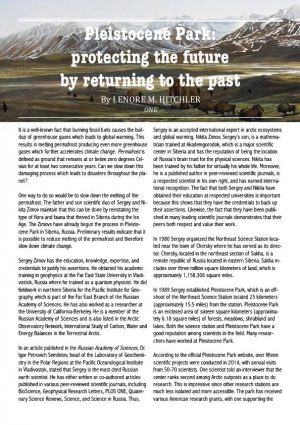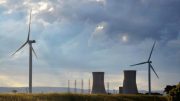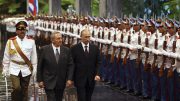 It is a well-known fact that burning fossil fuels causes the buildup of greenhouse gases which leads to global warming. This results in melting permafrost producing even more greenhouse gases which further accelerates climate change. Permafrost is defined as ground that remains at or below zero degrees Celsius for at least two consecutive years. Can we slow down this damaging process which leads to disasters throughout the planet?
It is a well-known fact that burning fossil fuels causes the buildup of greenhouse gases which leads to global warming. This results in melting permafrost producing even more greenhouse gases which further accelerates climate change. Permafrost is defined as ground that remains at or below zero degrees Celsius for at least two consecutive years. Can we slow down this damaging process which leads to disasters throughout the planet?
One way to do so would be to slow down the melting of the permafrost. The father and son scientific duo of Sergey and Nikita Zimov maintain that this can be done by reinstating the type of flora and fauna that thrived in Siberia during the Ice Age. The Zimovs have already begun the process in Pleistocene Park in Siberia, Russia. Preliminary results indicate that it is possible to reduce melting of the permafrost and therefore slow down climate change.
Sergey Zimov has the education, knowledge, expertise, and credentials to justify his assertions. He obtained his academic training in geophysics at the Far East State University in Vladivostok, Russia where he trained as a quantum physicist. He did fieldwork in northern Siberia for the Pacific Institute for Geography, which is part of the Far East Branch of the Russian Academy of Sciences. He has also worked as a researcher at the University of California-Berkeley. He is a member of the Russian Academy of Sciences and is also listed in the Arctic Observatory Network, International Study of Carbon, Water and Energy Balances in the Terrestrial Arctic.
In an article published in the Russian Academy of Sciences, Dr. Igor Petrovich Semiletov, head of the Laboratory of Geochemistry in the Polar Regions at the Pacific Oceanological Institute in Vladivostok, stated that Sergey is the most cited Russian earth scientist. He has either written or co-authored articles published in various peer-reviewed scientific journals, including BioScience, Geophysical Research Letters, PLOS ONE, Quaternary Science Reviews, Science, and Science in Russia. Thus, Sergey is an accepted international expert in arctic ecosystems and global warming. Nikita Zimov, Sergey’s son, is a mathematician trained at Akademgorodok, which is a major scientific center in Siberia and has the reputation of being the location of Russia’s brain trust for the physical sciences. Nikita has been trained by his father for virtually his whole life. Moreover, he is a published author in peer-reviewed scientific journals, is a respected scientist in his own right, and has earned international recognition. The fact that both Sergey and Nikita have obtained their education at respected universities is important because this shows that they have the credentials to back up their assertions. Likewise, the fact that they have been published in many leading scientific journals demonstrates that their peers both respect and value their work.
In 1980 Sergey organized the Northeast Science Station located near the town of Chersky where he has served as its director. Chersky, located in the northeast section of Sakha, is a remote republic of Russia located in eastern Siberia. Sakha includes over three million square kilometers of land, which is approximately 1,158,306 square miles.
In 1989 Sergey established Pleistocene Park, which is an offshoot of the Northeast Science Station located 25 kilometers (approximately 15.5 miles) from the station. Pleistocene Park is an enclosed area of sixteen square kilometers (approximately 6.18 square miles) of forests, meadows, shrubland and lakes. Both the science station and Pleistocene Park have a good reputation among scientists in the field. Many researchers have worked at Pleistocene Park.
According to the official Pleistocene Park website, over fifteen scientific projects were conducted in 2014, with annual visits from 50-70 scientists. One scientist told an interviewer that the center ranks second among Arctic outposts as a place to do research. This is impressive since other research stations are much less isolated and more accessible. The park has received various American research grants, with one supporting the center as a teaching lab and the other financially supporting remote sensing.
The goal of Pleistocene Park is to simulate the Pleistocene ecosystem in areas that were once known as the Mammoth Steppe, a grassland ecosystem which has been estimated to occupy one million square kilometers (approximately 386,102 square miles.) In other parts of the world, steppe types of ecosystems are called prairies, plains, or savanna. The Pleistocene epoch, commonly known as the Ice Age, began about 2.6 million years ago and ended around 11,700 years ago, at the start of the Holocene Epoch. During the Pleistocene mile-thick glaciers covered much of the northern hemisphere. However, the Mammoth Steppe was an exception as it was cold and dry. The Mammoth Steppe extended from France to Scandinavia, across all of Europe to Eurasia and then on to the Pacific land bridge and Canada.
The Mammoth steppe is considered to have been the world’s most extensive ecosystem with Pleistocene grassland ecosystems having occupied about half of the world’s landmass. The area was covered with grassland precisely because the cold air was too dry to produce enough snowfall to form glaciers. Fortunately, arctic grasses can photosynthesize and thrive at low temperatures. Many large mammals, including woolly mammoths, woolly rhinoceroses, horses, moose, saiga antelopes, reindeer, elk, bison, musk oxen, yaks, cave lions and wolves inhabited the region.
Before Sergey Zimov’s research, scientists theorized that during the Holocene Epoch climate change caused the area to evolve from a steppe grassland to a tundra/forest/swamp ecosystem. However, the Zimovs maintain that human hunting and eradication of large animals caused the ecosystem to change from a vast mammal grassland to a landscape with mosses, shrubs, and trees. The Zimovs substantiate their claims in an article published by Quaternary Science Reviews, which states:
“Analysis of fossil carbon-14 dates and reconstruction of mammoth steppe climatic envelope indicated that changing climate wasn’t a reason for extinction of this ecosystem. We calculate, based on animal skeleton density in frozen soils of northern Siberia, that mammoth-steppe animal biomass and plant productivity, even in these coldest and driest of the planet’s grasslands were close to those of an African savanna. Numerous herbivores maintained ecosystem productvity.”
Other scientists support this hypothesis. For example, Yadvinder Malhi, professor of ecosystem science at Oxford and one of the organizers of the “Megafauna and Ecosystem Function” conference also points out that the animals that lived in the Mammoth Steppe had previously survived millions of years of climate change.
Instead of climate change transforming the ecosystem, Sergey posits that over-hunting of herbivores changed the environment. Sergey Zimov is one of the authors of “Steppe-Tundra Transition: A Herbivore Driven Biome Shift at the End of the Pleistocene” in The American Naturalist published by the University of Chicago Press. The authors explain how grassland in the Mammoth Steppe is created and maintained: “Trampling and grazing by mammalian grazers in tundra cause a shift in dominance from mosses to grasses. … moss-dominated tundra is favored when grazing is reduced below levels that are in equilibrium with climate and vegetation. Together these results indicate that mammalian grazers have a sufficiently large effect on vegetation and soil moisture that their extinction could have contributed substantially to the shift from the predominance of steppe to tundra at the Pleistocene-Holocene boundary.”
Therefore, Sergey and Nikita are bringing back the types of animals that formerly lived in the area. According to the Pleistocene Park website, the Zimovs have already introduced bison, musk ox, moose, reindeer and horses to the park. The online site of Pleistocene Park states: “He [Sergey] hopes that by putting a lot of large grazing animals on to the modern tundra, they will chew up the mosses that currently keep the soil moist. The drier earth will then be suitable for grassland, which is what the animals prefer.”
Thus, the introduced herbivores will cause the current wet, boggy tundra to revert to the dry grasslands that once covered the area. The high plant productivity found in grasslands reduces soil moisture and will result in less methane being produced. Methane is more than 25 times more potent as carbon dioxide (CO2) at trapping heat in the atmosphere.
Carbon dioxide, methane and other greenhouse gases are causing the Arctic to quickly warm up and this has already caused some melting of the permafrost. Microbes are digesting organic material that was previously sequestered in the permafrost producing either carbon CO2 or methane depending on whether or not the digestion occurs with or without oxygen. For instance, when lake bottoms are filled with melted permafrost, microbes in their digestion process produce bubbles of methane which rise to the surface. Already more than one million of these lakes dot the Arctic, and NASA finds new ones in their satellite images every year.
Unfortunately, an immense amount of carbon is stored in permafrost and this carbon is released into the atmosphere when permafrost melts. And it has been estimated that the permafrost is one mile thick in places. The Zimovs are not the only scientists who are extremely concerned about the dangers of melting permafrost.
For example, Julian Merton, member of the International Permafrost Association, states that “The methane and carbon dioxide levels will increase as a result of permafrost degradation.” There are many different estimates of the total amount of carbon in the permafrost. For instance, Sergey states that “permafrost areas hold 500 billion Tongans of carbon.” It has been estimated that the melting of the world’s permafrost is equivalent to burning all of the world’s forests 2 ½ times.
On a hot day, the permafrost can melt by as much as 20 centimeters, approximately 7.87 inches. In summer, the permafrost recedes by 3 meters, approximately 3.28 yards. As a result of permafrost melting in Chersky, a small town near Pleistocene Park, apartment blocks have cracks running through their walls because of subsiding (sunken) land and some have been demolished as unsafe. Whole houses have already sunk into the mud. This is an illustration of why Sergey stated that “This is the most dangerous territory in the world in terms of climate change.”
Preliminary results from Pleistocene Park find that where the herbivores trample the snow to get at the grass underneath the soil temperatures are lower. The temperature difference is enough to protect the permafrost from melting. In winter when the air temperature has been recorded as minus 40 degrees Celsius, (about minus 40 degrees Fahrenheit) the temperature of snow-covered ground was minus 5 degrees Celsius, (about 23 degrees Fahrenheit.) However, in places where the animals trampled down the snow, the ground temperature was minus 30 degrees Celsius (about minus 22 degrees Fahrenheit.)
It has been estimated that permafrost covers approximately 25% of the Northern Hemisphere landmass. Thus, melting permafrost could rapidly and profoundly increase global warming. Fortunately, the largest concentrations of carbon are found in northeast Siberia, central Alaska, and the Yukon Territory of Canada. This means that if the Zimovs are proven correct, then only these specific areas will need new herbivores introduced to keep the permafrost from melting.
Besides grassland ecosystems keeping the permafrost itself from melting and releasing C02, they are considered the most effective carbon sink on Earth. In the summer the growing grass consumes CO2 and the plant stores carbon in its tissues as well as building up carbon storage in the soil. Since grass insulates the permafrost from warming temperature, melting permafrost would slow down.
Forests and shrublands are dark year round and absorb considerable amounts of the sun’s radiation. Thus, they contribute to the greenhouse effect. Whereas grasslands are lighter and are white in the winter when covered in snow, and they reflect more of the sun’s heat and help slow down global warming.
Therefore, creating more grasslands by reintroducing herbivores will help slow down global warming several ways. Herbivores trample down the snow thus enabling colder winds and temperatures to keep the permafrost cooler. Additionally, the white snow covering the grassland, as opposed to the darker shrublands and tree cover, will reflect more sunlight thus slowing down the greenhouse effect. Also, the new grasslands will store CO2 in the grass and in the soil which will also help stop global warming. Thus, by bringing back the types of flora and fauna found during the Pleistocene era, climate change can be slowed down.
Otherwise melting permafrost will add to the greenhouse effect and cause rapid global warming that will jeopardize the future of society. Some of these threats to humanity are rising sea levels, toxic amounts of C02 in the oceans, floods, droughts, the loss of glaciers which provide one-sixth of the world’s population who depend upon glacier-fed rivers for drinking and irrigation, and the loss of species that humans depend upon. Pleistocene Park includes many species of herbivores, including reindeer.
Perhaps someday instead of singing these lines from Rudolph the Red Nose Reindeer:
Then how the reindeer loved him
As they shouted out with glee
Rudolph the Red-Nosed reindeer
You’ll go down in history
we will sing:
Then how humanity loved grasslands
As they shouted out with glee
Pleistocene Park
You’ll go down in history
Lenore Hitchler





